Expansion of E-commerce Platforms
The rapid expansion of e-commerce platforms in Japan is significantly influencing the 2d barcode-reader market. With online shopping becoming increasingly popular, retailers are investing in technologies that enhance the customer experience and streamline order fulfillment. The use of 2d barcode readers allows for efficient inventory management and quick processing of online orders, which is vital in a competitive e-commerce landscape. Recent statistics indicate that e-commerce sales in Japan are expected to reach ¥20 trillion by 2025, highlighting the growing reliance on technology to support this sector. Consequently, the 2d barcode-reader market is poised for growth as businesses adapt to the demands of online retailing.
Rising Demand for Automation in Logistics
The 2d barcode-reader market in Japan is experiencing a notable surge in demand due to the increasing automation in logistics and supply chain management. Companies are adopting advanced technologies to enhance operational efficiency, reduce human error, and streamline processes. The integration of 2d barcode readers facilitates real-time tracking of inventory, which is crucial for maintaining optimal stock levels. According to recent data, the logistics sector in Japan is projected to grow at a CAGR of 5.2% from 2025 to 2030, further driving the need for efficient barcode scanning solutions. As businesses seek to optimize their operations, the The 2D barcode-reader market is likely to benefit significantly from this trend. It is positioning itself as an essential tool in modern logistics management.
Technological Advancements in Scanning Solutions
Technological advancements in scanning solutions are playing a pivotal role in shaping the 2d barcode-reader market in Japan. Innovations such as improved imaging technology and enhanced decoding algorithms are making barcode readers faster and more accurate. These advancements not only increase the efficiency of scanning processes but also expand the range of applications for 2d barcode readers across various industries, including healthcare, retail, and manufacturing. As organizations seek to leverage these technologies to improve operational efficiency, the market for 2d barcode readers is likely to witness substantial growth. The introduction of features such as wireless connectivity and integration with cloud-based systems further enhances the appeal of these devices.
Government Initiatives Supporting Digital Transformation
Government initiatives aimed at promoting digital transformation in Japan are significantly impacting the 2d barcode-reader market. Policies encouraging the adoption of smart technologies across various sectors are fostering an environment conducive to the growth of barcode scanning solutions. The Japanese government has set ambitious targets for digitalization, which include enhancing the efficiency of public services and supporting businesses in their technological upgrades. As a result, the demand for 2d barcode readers is expected to rise as organizations align with these initiatives. The market is likely to benefit from increased investments in technology, which could lead to a more robust infrastructure for barcode scanning applications.
Growing Focus on Data Analytics and Inventory Management
The growing focus on data analytics and inventory management is driving the 2d barcode-reader market in Japan. Businesses are increasingly recognizing the importance of data-driven decision-making to optimize their operations. 2d barcode readers facilitate the collection of valuable data regarding inventory levels, sales trends, and customer preferences. This data can be analyzed to improve supply chain efficiency and enhance customer satisfaction. As companies strive to leverage data analytics for competitive advantage, the demand for 2d barcode readers is likely to increase. The market is expected to expand as organizations invest in technologies that enable better inventory management and informed decision-making.

















Leave a Comment